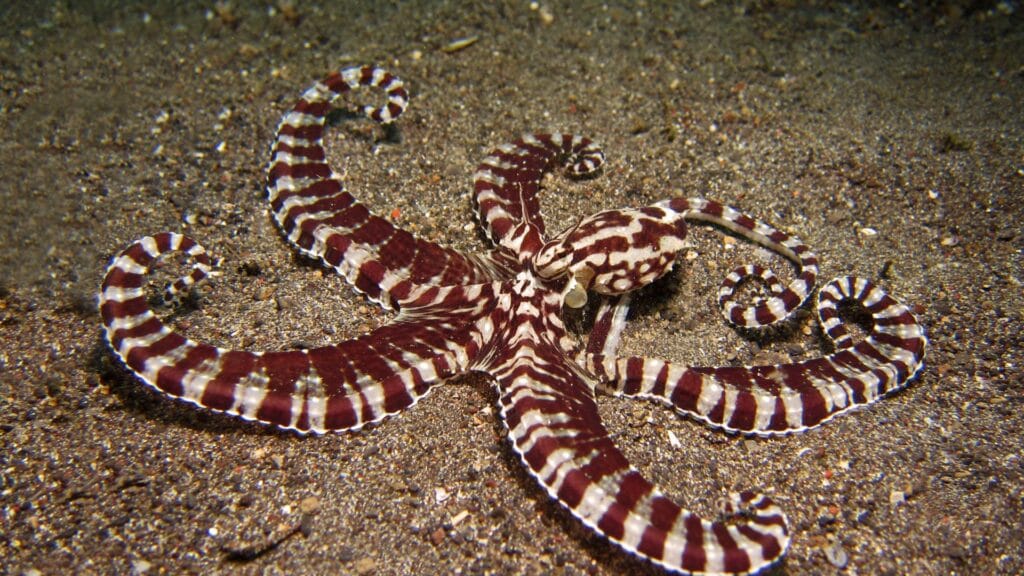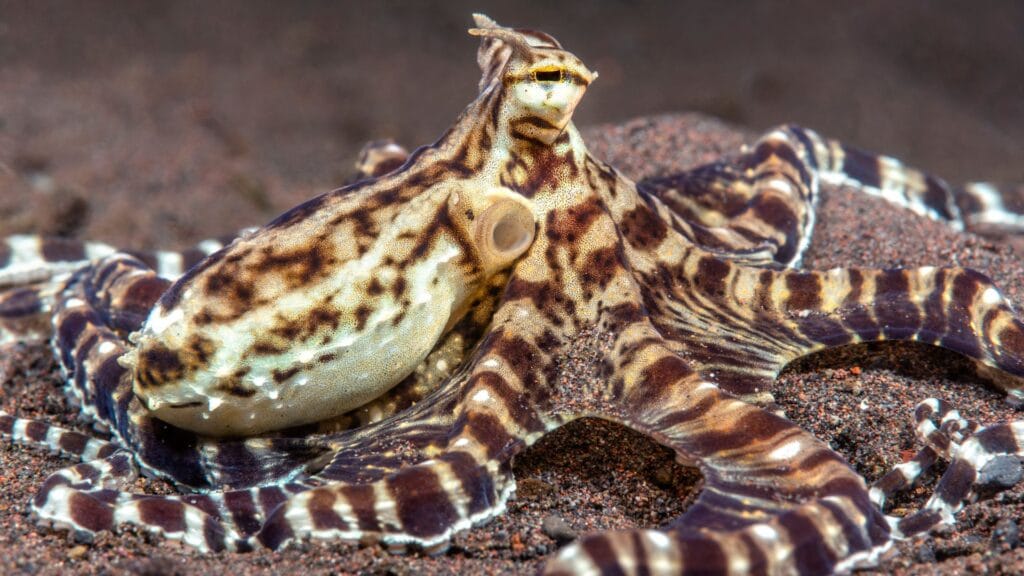| Category | Details |
| Scientific Name | Thaumoctopus mimicus |
| Average Weight | 1.4 kg (3 pounds) |
| Size (Length) | Up to 60 cm (2 feet long) |
| Habitat | Shallow, sandy ocean floors in Indo-pacific region |
| Diet | Small fish, crabs, worms |
| Predators | Lionfish, Sea Snakes, and Jellyfish |
| Lifespan | 1–2 years |
| Special Abilities | Can mimic 15+ animals, change color/texture, and squeeze into tiny spaces! |
| Conservation Status | Not endangered yet |
Have you ever heard of an octopus that can pretend to be a snake, a crab, or even a fish? Meet the mimic octopus a sea creature so clever it can change its shape, color, and behavior to look like other animals! Let’s dive into the amazing world of this underwater magician and learn why it’s one of the ocean’s coolest tricksters.
What Is a Mimic Octopus?
The mimic octopus (scientifically called Thaumoctopus mimicus) is a small, smart octopus that lives in shallow waters in Indo-pacific region. Its natural color is usually light brown or beige, which helps it blend in with the sandy ocean floor.
It’s about 60 cm (2 feet long) and has long, bendy arms covered in stripes and spots, and weigh about 1.4 kg (3 pounds).
Why Is It Called the “Mimic”?
The word “mimic” means “to copy,” and this octopus is the ultimate copycat! While many octopuses can change color to blend in, the mimic octopus act like dangerous sea creatures. For example:
- Lionfish
- Sea snake
- Crab
- Small sponges
- Tube worms
- Colonial tunicates
Scientists think this talent helps it scare off enemies or sneak up on prey without being noticed.

How Does It Pull Off These Tricks?
The mimic octopus has two superpowers:
- Color-Changing Skin: Tiny cells in its skin (called chromatophores) let it switch colors in seconds.
- Flexible Body: Its soft, boneless body can twist, stretch, and flatten into almost any shape.
But the coolest part? It doesn’t just copy looks, it copies behaviors too! If it pretends to be a crab, it might even walk sideways on the ocean floor.
Who Wants to Eat a Mimic Octopus?
They can fall prey to lionfish, sea snakes, and jellyfish that like to eat small creatures. These predators use their strong jaws and keen senses to find food, and mimic octopuses must be very careful.
What’s for Dinner?
Mimic Octopus eats on small fish, crabs, and worms. They crawl or bury itself in sandy seabeds, using its stretchy arms to explore cracks, dig into holes, and sweep the sand like eight super-powered fishing lines. Each arm has special “taste-and-touch” suckers that help it sniff out snacks!
To hunt, it shape-shifts into different animals or quietly glides over the sand by shooting water, sneaking up on prey or grabbing a bite to eat along the way.
Life cycle of a Mimic Octopus
Mimic octopuses, like other octopuses, have a fascinating life cycle. The male uses a special arm, called a hectocotylus, to transfer sperm to the female. After mating, the male dies within a few months.
The female lays hundreds or thousands of eggs and carefully guards them, keeping them clean and protected. After they hatch, the tiny octopuses drift in ocean currents, learning to survive and mimic other creatures. The mother dies soon after her babies emerge.
Sadly, mimic octopuses don’t live very long (about 1-2 years).
Fun Facts to Blow Your Mind!
- They were only discovered in 1998; scientists didn’t know about them until recently!
- They can mimic at least 15 different animals.
- Unlike most octopuses, they’re active during the day.
Final Thoughts
The mimic octopus proves that you don’t need super strength to survive, you just need creativity. By studying this animal, scientists learn how life adapts in the ocean.
References

